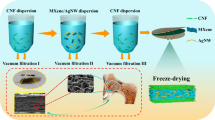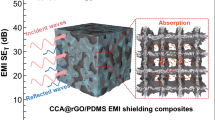Abstract
Multifunctional materials with high electromagnetic interference (EMI) shielding effectiveness and thermal conductivity (TC) are an essential guarantee for the rapid advancement of next-generation electronic products. Herein, the three-dimensional porous conductive/thermal network of carbon nanotubes (CNT)/cellulose is prefabricated by “solution-gelation-solvent exchange-freeze drying”. Using “impregnation and high-pressure compression molding”, CNT/cellulose-boron nitride/polyvinyl alcohol (CNT/cellulose-BN/PVA) composite films with three-dimensional dual-continuous network structure are constructed to provide a perfect pathway for both electrons and phonons transportation. Comprehensive performance of the composites before and after hot-pressing including the microstructure, electrical conductivity, EMI shielding and thermal conductivity is investigated. Benefiting from the high-pressure compression molding process, the composite is densified and a close contact between fillers is achieved, which effectively improves the electrical and thermal conductivity. The finally obtained CNT/cellulose-BN/PVA composite film exhibits satisfactory EMI shielding performance, high in-plane and cross-plane TC, as well as excellent Joule heating performance, demonstrating enormous potential as high-performance EMI shielding and thermal management materials in practical applications. The significance of this work is to give an inspiration for improving the comprehensive performance of electromagnetic shielding and thermal conductive materials.







Similar content being viewed by others
References
Aleksandrova M, Jagtap C, Kadam V, Jadkar S, Kolev G, Denishev K, Pathan H (2021) An overview of microelectronic infrared pyroelectric detector. Eng Sci 16:82–89. https://doi.org/10.30919/es8d535
Bai T et al (2020) Achieving enhanced electromagnetic shielding and absorption capacity of cellulose-derived carbon aerogels via tuning the carbonization temperature. J Mater Chem C 8:5191–5201. https://doi.org/10.1039/d0tc00448k
Bhattacharjee Y, Chatterjee D, Bose S (2018) Core–multishell heterostructure with excellent heat dissipation for electromagnetic interference shielding. ACS Appl Mater Interfaces 10:30762–30773. https://doi.org/10.1021/acsami.8b10819
Chen J, Huang X, Zhu Y, Jiang P (2017) Cellulose nanofiber supported 3D interconnected BN nanosheets for epoxy nanocomposites with ultrahigh thermal management capability. Adv Funct Mater 27:1604754. https://doi.org/10.1002/adfm.201604754
Chen Q, Huang L, Wang X, Yuan Y (2023) Transparent and flexible composite films with excellent electromagnetic interference shielding and thermal insulating performance. ACS Appl Mater Interfaces 15:24901–24912. https://doi.org/10.1021/acsami.3c03140
Cheng Y et al (2021) Electric current aligning component units during graphene fiber Joule heating. Adv Funct Mater 32:2103493. https://doi.org/10.1002/adfm.202103493
Fan M et al (2022) Flexible microfibrillated cellulose/carbon nanotube multilayered composite films with electromagnetic interference shielding and thermal conductivity. Compos Commun 35:101293. https://doi.org/10.1016/j.coco.2022.101293
Fu C, Sheng Z, Zhang X (2022) Laminated structural engineering strategy toward carbon nanotube-based aerogel films. ACS Nano 16:9378–9388. https://doi.org/10.1021/acsnano.2c02193
Ghaffari-Mosanenzadeh S, Aghababaei Tafreshi O, Dammen-Brower E, Rad E, Meysami M, Naguib HE (2021) A review on high thermally conductive polymeric composites. Polym Compos 43:692
Han G et al (2021) Cellulose-based Ni-decorated graphene magnetic film for electromagnetic interference shielding. J Colloid Interface Sci 583:571–578. https://doi.org/10.1016/j.jcis.2020.09.072
Hu YF et al (2022) Spherical boron nitride/silicone rubber composite with high isotropic thermal conductivity via pre-constructing thermally conductive networks. J Appl Polym Sci 139:e52901. https://doi.org/10.1002/app.52901
Jiang S et al (2022) Development of a multifunctional nanocomposite film with record-high ultralow temperature toughness and unprecedented fatigue-resistance. Chem Eng J 432:134408. https://doi.org/10.1016/j.cej.2021.134408
** X et al (2020) Flame-retardant poly(vinyl alcohol)/MXene multilayered films with outstanding electromagnetic interference shielding and thermal conductive performances. Chem Eng J 380:122475. https://doi.org/10.1016/j.cej.2019.122475
Kwon OH et al (2018) Anisotropy-driven high thermal conductivity in stretchable poly(vinyl alcohol)/hexagonal boron nitride nanohybrid films. ACS Appl Mater Interfaces 10:34625–34633. https://doi.org/10.1021/acsami.8b12075
Lai D, Chen X, Xu X, Wang G, Wang Y (2022) Elastomeric foldable and high-temperature endurance porous graphene films with superior electromagnetic interference shielding performance. Ind Eng Chem Res 61:1122–1132. https://doi.org/10.1021/acs.iecr.1c04201
Li R, Lin H, Lan P, Gao J, Huang Y, Wen Y, Yang W (2018) Lightweight cellulose/carbon fiber composite foam for electromagnetic interference (EMI) shielding. Polymers 10:1319. https://doi.org/10.3390/polym10121319
Li Y, Gong C, Li C, Ruan K, Liu C, Liu H, Gu J (2021) Liquid crystalline texture and hydrogen bond on the thermal conductivities of intrinsic thermal conductive polymer films. J Mater Sci Technol 82:250–256. https://doi.org/10.1016/j.jmst.2021.01.017
Li Y et al (2022) Carbon nanotubes/cellulose composite aerogels with controllable microstructure for electromagnetic interference shielding. J Appl Polym Sci 140:e53535. https://doi.org/10.1002/app.53535
Liu J, Zhang HB, Sun R, Liu Y, Liu Z, Zhou A, Yu ZZ (2017) Hydrophobic, flexible, and lightweight MXene foams for high-performance electromagnetic-interference shielding. Adv Mater 29:1702367. https://doi.org/10.1002/adma.201702367
Liu H, Huang Z, Chen T, Su X, Liu Y, Fu R (2022) Construction of 3D MXene/silver nanowires aerogels reinforced polymer composites for extraordinary electromagnetic interference shielding and thermal conductivity. Chem Eng J 427:131540. https://doi.org/10.1016/j.cej.2021.131540
Niu HT, Zhang Y, **ao G, He XH, Yao YG (2023) Preparation of quasi-isotropic thermal conductive composites by interconnecting spherical alumina and 2D boron nitride flakes. Rare Met 42:1283–1293. https://doi.org/10.1007/s12598-022-02195-8
Pan D et al (2021) Ice template method assists in obtaining carbonized cellulose/boron nitride aerogel with 3D spatial network structure to enhance the thermal conductivity and flame retardancy of epoxy-based composites. Adv Compos Hybrid Mater 5:58–70. https://doi.org/10.1007/s42114-021-00362-6
Pan D et al (2022) Vertically aligned silicon carbide nanowires/boron nitride cellulose aerogel networks enhanced thermal conductivity and electromagnetic absorbing of epoxy composites. Nano-Micro Lett 14:118. https://doi.org/10.1007/s40820-022-00863-z
Pogorielov M, Smyrnova K, Kyrylenko S, Gogotsi O, Zahorodna V, Pogrebnjak A (2021) MXenes-a new class of two-dimensional materials: structure, properties and potential applications. Nanomaterials 11:3412. https://doi.org/10.3390/nano11123412
Ran L et al (2023) Fabrication of MXene based sandwich-like films for excellent flexibility, electromagnetic interference shielding and thermal management. Compos Part A Appl Sci Manuf 173:107672. https://doi.org/10.1016/j.compositesa.2023.107672
Shahzad F, Alhabeb M, Hatter CB, Anasori B, Man Hong S, Koo CM, Gogotsi Y (2016) Electromagnetic interference shielding with 2D transition metal carbides (MXenes). Science 353:1137–1140. https://doi.org/10.1126/science.aag2421
Song W, Zhao X, ** Z, Fan L, Ji X, Deng J, Duan J (2023) Poly(vinyl alcohol) for multi-functionalized corrosion protection of metals: a review. J Clean Prod. https://doi.org/10.1016/j.jclepro.2023.136390
Song P et al (2021) Lightweight, flexible cellulose-derived carbon aerogel@reduced graphene oxide/PDMS composites with outstanding EMI shielding performances and excellent thermal conductivities. Nano-Micro Lett 13:91. https://doi.org/10.1007/s40820-021-00624-4
Tan X, Yuan Q, Qiu M, Yu J, Jiang N, Lin C-T, Dai W (2022) Rational design of graphene/polymer composites with excellent electromagnetic interference shielding effectiveness and high thermal conductivity: a mini review. J Mater Sci Technol 117:238–250. https://doi.org/10.1016/j.jmst.2021.10.052
Wan YJ et al (2020) Ultrathin densified carbon nanotube film with “metal-like” conductivity, superior mechanical strength, and ultrahigh electromagnetic interference shielding effectiveness. ACS Nano 14:14134–14145. https://doi.org/10.1021/acsnano.0c06971
Wang D, Zhang M, Guo Y, Bai T, Liu H, Liu C, Shen C (2022a) Facile preparation of a cellulose derived carbon/BN composite aerogel for superior electromagnetic wave absorption. J Mater Chem C 10:5311–5320. https://doi.org/10.1039/d2tc00205a
Wang J, Hu L, Li W, Ouyang Y, Bai L (2022b) Development and perspectives of thermal conductive polymer composites. Nanomaterials 12:3574. https://doi.org/10.3390/nano12203574
Wang M et al (2020) Facile fabrication of hildewintera-colademonis-like hexagonal boron nitride/carbon nanotube composite having light weight and enhanced microwave absorption. J Colloid Interface Sci 564:454–466. https://doi.org/10.1016/j.jcis.2019.12.124
Wang ZG et al (2021) Highly thermally conductive graphene-based thermal interface materials with a bilayer structure for central processing unit cooling. ACS Appl Mater Interfaces 13:25325–25333. https://doi.org/10.1021/acsami.1c01223
**ao C, Guo Y, Tang Y, Ding J, Zhang X, Zheng K, Tian X (2020) Epoxy composite with significantly improved thermal conductivity by constructing a vertically aligned three-dimensional network of silicon carbide nanowires/boron nitride nanosheets. Compos Part B Eng 187:107855. https://doi.org/10.1016/j.compositesb.2020.107855
Xu H, Yin X, Li X, Li M, Liang S, Zhang L, Cheng L (2019) Lightweight Ti2CTx MXene/poly(vinyl alcohol) composite foams for electromagnetic wave shielding with absorption-dominated feature. ACS Appl Mater Interfaces 11:10198–10207. https://doi.org/10.1021/acsami.8b21671
Xu J et al (2021) Multifunctional graphene microstructures inspired by honeycomb for ultrahigh performance electromagnetic interference shielding and wearable applications. ACS Nano 15:8907–8918. https://doi.org/10.1021/acsnano.1c01552
Xue Y et al (2018) Densely interconnected porous BN frameworks for multifunctional and isotropically thermoconductive polymer composites. Adv Funct Mater 28:1801205. https://doi.org/10.1002/adfm.201801205
Yang W et al (2017) Ultrathin flexible reduced graphene oxide/cellulose nanofiber composite films with strongly anisotropic thermal conductivity and efficient electromagnetic interference shielding. J Mater Chem C 5:3748–3756. https://doi.org/10.1039/c7tc00400a
Yang W et al (2021) Three-dimensional skeleton assembled by carbon nanotubes/boron nitride as filler in epoxy for thermal management materials with high thermal conductivity and electrical insulation. Compos Part B Eng 224:109168. https://doi.org/10.1016/j.compositesb.2021.109168
Zha XH et al (2016) Promising electron mobility and high thermal conductivity in Sc2CT2 (T = F, OH) MXenes. Nanoscale 8:6110–6117. https://doi.org/10.1039/c5nr08639f
Zhang LQ, Yang B, Teng J, Lei J, Yan DX, Zhong GJ, Li ZM (2017) Tunable electromagnetic interference shielding effectiveness via multilayer assembly of regenerated cellulose as a supporting substrate and carbon nanotubes/polymer as a functional layer. J Mater Chem C 5:3130–3138. https://doi.org/10.1039/c6tc05516h
Zhang Y, Ruan K, Zhou K, Gu J (2023) Controlled distributed Ti3C2Tx hollow microspheres on thermally conductive polyimide composite films for excellent electromagnetic interference shielding. Adv Mater 35:e2211642. https://doi.org/10.1002/adma.202211642
Zhang LQ et al (2018) Ultralight cellulose porous composites with manipulated porous structure and carbon nanotube distribution for promising electromagnetic interference shielding. ACS Appl Mater Interfaces 10:40156–40167. https://doi.org/10.1021/acsami.8b14738
Zhang LQ et al (2020) Polylactide porous biocomposites with high heat resistance by utilizing cellulose template-directed construction. Cellulose 27:3805–3819. https://doi.org/10.1007/s10570-020-03056-2
Zhao X et al (2020) Smart Ti3C2Tx MXene fabric with fast humidity response and Joule heating for healthcare and medical therapy applications. ACS Nano 14:8793–8805. https://doi.org/10.1021/acsnano.0c03391
Zhu G, Giraldo Isaza L, Huang B, Dufresne A (2022) Multifunctional nanocellulose/carbon nanotube composite aerogels for high-efficiency electromagnetic interference shielding. ACS Sustain Chem Eng 10:2397–2408. https://doi.org/10.1021/acssuschemeng.1c07148
Acknowledgments
The authors gratefully acknowledge the National Natural Science Foundation of China (52103127), the Natural Science Basic Research Program of Shaanxi (No. 2021JQ-564), the Opening Project of State Key Laboratory of Polymer Materials Engineering (Sichuan University) (No. sklpme2022-4-10), the China Postdoctoral Science Foundation (2022T150512), the Natural Science Basic Research Program of Shaanxi Province (No. 2021JC-48).
Funding
This work was supported by funds from the National Natural Science Foundation of China (52103127), the Natural Science Basic Research Program of Shaanxi (No. 2021JQ-564), the Opening Project of State Key Laboratory of Polymer Materials Engineering (Sichuan University) (No. sklpme2022-4–10), the China Postdoctoral Science Foundation (2022T150512), the Natural Science Basic Research Program of Shaanxi Province (No. 2021JC-48).
Author information
Authors and Affiliations
Contributions
All authors contributed to the study conception and design. Material preparation, data collection, analysis, and writing-original draft were performed by LZ and FZ. Conceptualization and wring-review and editing were performed by QS, ZZ, SY and DY. Supplemental tests and analysis in revision of the manuscript and Supporting Information were performed by LZ, FZ, LP and XZ. All authors commented on previous versions of the manuscript. All authors read and approved the final manuscript.
Corresponding author
Ethics declarations
Conflict of interest
The authors declared no potential conflicts of interest concerning the research, authorship and/or publication of this article.
Ethical approval
We declare that there is no financial or personal relationship between us and other people or organizations that may have an inappropriate impact on this work.
Consent to participate
Informed consent was obtained from all individual participants included in the study.
Consent for publication
We have read the publishing policy and submit this manuscript in accordance with the policy. All authors have agreed to publish this article.
Additional information
Publisher's Note
Springer Nature remains neutral with regard to jurisdictional claims in published maps and institutional affiliations.
Supplementary Information
Below is the link to the electronic supplementary material.
Rights and permissions
Springer Nature or its licensor (e.g. a society or other partner) holds exclusive rights to this article under a publishing agreement with the author(s) or other rightsholder(s); author self-archiving of the accepted manuscript version of this article is solely governed by the terms of such publishing agreement and applicable law.
About this article
Cite this article
Zhang, LQ., Zhou, F., Shi, Q. et al. Multifunctional cellulose composite films with dual-continuous CNT/BN networks for synchronously enhanced electromagnetic interference shielding ability and thermal conductivity. Cellulose 31, 2397–2412 (2024). https://doi.org/10.1007/s10570-024-05767-2
Received:
Accepted:
Published:
Issue Date:
DOI: https://doi.org/10.1007/s10570-024-05767-2




